|
|
Reel

|
|
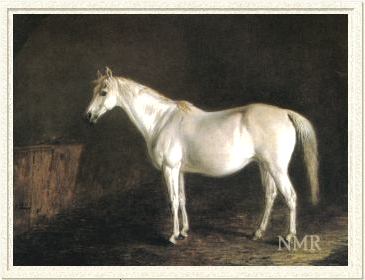 |
|
|
Reel was not
only a great racemare in her time, but was one of the most important
American broodmares of the 1800s. She was also the premier American-bred
mare by the great broodmare sire *Glencoe. Her portrait, painted by
Edward Troye, is one of the treasures of The Jockey Club, and hangs
in its board room in New York City.
Reel's sire was
*Glencoe, winner of the 2,000 Guineas and Ascot Gold Cup in England.
After his racing career, *Glencoe was purchased by Alabama horse breeder
James Jackson and stood the 1836 breeding season in England before
his importation; his first crop included the great broodmare Pocahontas,
dam of Stockwell, King Tom, and Rataplan. He stood his first American
season in 1837 at Jackson's plantation Forks of Cypress,
near Florence, Alabama, where he covered Jackson's English-bred *Galopade.
*Galopade's two previous foals were Fandango, 1836, and Cotillion,
1837, both by *Leviathan. Both proved highly successful broodmares
when bred to Reel's sire, *Glencoe.
As a yearling,
Jackson sold a half interest in the *Glencoe - *Galopade filly to
General Thomas Jefferson Wells for $1,000. Wells, owner of Wellswood,
a huge plantation near Alexandria, Louisiana, gained sole ownership
of the grey filly before she raced at three. In the autumn of 1841,
Reel debuted at the Louisiana Course in New Orleans. She won her first
two races in 2-mile heats, and then won the Jockey Club Purse in 4-mile
heats. This was particularly remarkable for such a young runner. She
remained undefeated through four more races at age 4, including a prestigious
victory in a match with Miss Foote held at the Metairie Race Course,
also in New Orleans, winning in straight heats. She defeated colts
and nearly bested Fashion's American record for 4 miles (7:32), running
at Metairie and the Louisiana Course in Opelousas.
Her only loss
came in what was to be her final start. At the Louisiana Course, while
running down the colt George Martin in the final mile, 5-year-old
Reel took a bad step. Still trying, she
could not catch him. And so her racing career came to an end in the
same place where it began. The
Spirit of the Timesnoted, "Reel passes off the scene, leaving
the deep impression on many minds that she had no rival in the United
States..." She retired with 7 wins in 8 starts.
|
|
|
|
As a broodmare,
Reel improved on her record. She produced 13 foals, 10 of which
were top class runners. In her first season, Reel was bred to *Leviathan
(standing at George Elliott's Wall Spring Stud in Tennessee) and produced
the chestnut colt Lincoln, in 1844. Returned to *Leviathan, she foaled
Stafford, a grey colt born in 1845, who was sent to Texas, where Wells
owned some land. In foal for a third time to *Leviathan, she was sent
to north Kentucky where she foaled Captain Elgee and lived out the
remainder of her days. James A. Grinstead (Walnut Hill Farm) managed
Wells' horses in Kentucky and boarded them at the farm of J.R. Gross
on the Winchester Pike, on the east side of Lexington near Henry Clay's
Ashland Stud.
Captain Elgee,
her 1846 colt by *Leviathan, was a good winner and sired a pair of
important daughters, both born in 1863 and out of mares by *Albion.
Wenonah produced the 1879 Kentucky Derby winner Lord Murphy and his
half-sister Sue Walton, dam of the stakes winner Barrett. Lantana
produced the 1879 Kentucky Oaks winner Liahtunah (dam of stakes winner
Gipsy Queen), and her half-sister Poca Wiley (third dam of the 1903
champion juvenile Highball).
Reel's best offspring
was Lecomte, her 1850 colt by Boston. A bright red chestnut like his
sire, Lecomte was an outstanding runner, overshadowed only by his
kinsman, Lexington, another son of Boston. Racing for his breeder,
Gen. Wells, Lecomte broke his maiden at 3 at Metairie over mile heats,
running the second heat in the fastest time ever to date. He won 4
more races prior to his first loss, to Lexington, in the Great Post
Stakes at Metairie in April 1854. One week later, in the Jockey Club
Purse, he defeated Lexington in four straight 1-mile heats, handing the
mighty Lexington his only defeat, and set a new American record for
4 miles (7:26) in the process. In all, Lecomte won 16 races in America.
| |
Temporarily sidelined
with a lameness, Wells bred Lecomte to a few mares in the spring of 1856.
Later that year, Wells dispersed most of his stock (with the most
obvious exception being Reel) and Lexington's owner, Richard Ten Broeck,
purchased Lecomte for $10,000 and sent him to England. This trip proved
abortive. Lecomte ran third (and last) in his only English start,
the Warwick Cup over 3 miles. He came out of the race lame, and died
shortly theafter from a bout of colic in 1857. [The town of Lecompte,
Louisiana was named after the local hero, the racehorse. A "p"
was added to the name later. The Lecomte Stakes is run in his honor
every spring at the Fair Grounds in New Orleans.]
From the few
foals in his only crop, born in 1857, Lecomte sired Umpire, a good
stakes winner when sent to England, as well as Uncle Jeff, and a unnamed
filly out of Edith (by *Sovereign), who was purchased at the dispersal
of Wells' bloodstock by Col. George Garner. She produced Lizzie G.
by Lecomte's three-quarter brother War Dance (see below). Lizzie G.
was the dam of Mannie Gray, herself dam of the great runner and sire
Domino, his sister, champion Correction (ancestress of Triple Crown
hero Affirmed), as well as granddam of another champion and leading
sire, Hamburg.
|
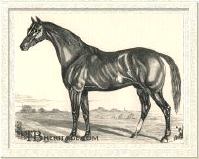
Lecomte by Boston
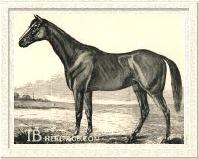
Prioress by Imp. Sovereign
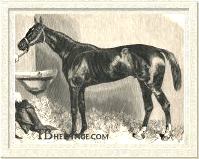
Starke by Wagner
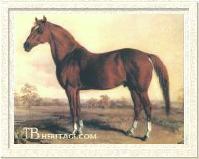
War Dance by Lexington
| |
Reel is also
remarkable for being the dam of Prioress, a bay filly foaled in 1853
by *Sovereign. As a 2-year-old, Prioress set a record for 1-mile heats,
winning in 1:46 1/4 and 1:45 at the Metairie Course. Purchased for
$2,500 by Richard Ten Broeck at the Wells Dispersal, she joined Lecomte
as part of the invasion force sent to England by Broeck in 1856. Prioress
(carrying 93 pounds) finished in a cavalry charge in the 1857 Cesarewitch
Stakes at Newmarket, triple dead-heating with El Hakim (93 pounds)
and Queen Bess (66 pounds). Because she was an old hand at heat racing,
which had gone out of style long before in England, Prioress was well
prepared to win the run off and take the prize, becoming the first
American-bred and American-owned horse to win a major race in England.
She later won the Great Yorkshire Handicap, as well as Queen's Plates
at Epsom and Newmarket. Prioress was a broodmare in England, producing
6 foals, none of note. She died in 1868 delivering her last foal.
The Prioress Stakes (G1), run at Belmont Park in New York each spring
is named in this filly's honor.
In 1855, Reel
produced the chestnut colt Starke by Wagner. Also purchased by Broeck
from the Wells Dispersal in 1856, he was sent to England and raced
quite successfully. In 1859, he won the Goodwood Stakes over 2 1/2
miles, and the Bentinck Memorial (3 miles, 5 furlongs), and the 3
mile Warwick Cup. As a 5-year-old in 1861, Starke won the prestigious
Goodwood Cup (2 1/2 miles) and the Brighton Stakes (1 3/4 miles, "...in a walk."). In November of 1861, after his Goodwood and Brighton Stakes wins that year, Ten Broeck sold Starke for $7,000 to Prussia, where he was sent to stud.
Reel produced
only three fillies, Ann Dunn (1848), Prioress (1853) and Fanny Wells
(1858), all sired by *Sovereign, who stood at Bosque Bonita Stud in
Woodford County, Kentucky. Ann Dunn died in training in New Orleans
at the age of 4. Prioress' produce record has already been mentioned;
she produced nothing of note. Fanny Wells, the youngest sister of
this trio proved to be the most influential.
Fanny Wells produced
two stakes winners, Nellie Grey (1868 f. by Commodore), and Jils Johnson
(1876 c. by Longfellow). Jils Johnson sired the mares Famine (dam
of the champion steeplechaser Good and Plenty) and Belle of Nantura,
an important broodmare whose line continues today. Nellie Grey's sister,
Rosaline produced Roke (granddam of champion Waterboy), and Rosary
(dam of Vespers, through which Reel's branch of the 23 family comes
into modern times to champions Two Lea, Tim Tam, Chris Evert, Chief's
Crown, and Winning Colors). Fanny Wells' daughter Rena B (sired by
the horse Ten Broeck), was the ancestress of the good fillies Gowell
(champion 2yo filly of 1912) and Wistful (1917 C.C.A. Oaks).
|
The last foal
out of Reel was the flashy chestnut colt, War Dance, sired by Lexington.
[The American Stud Book has him as born in 1859, but Mackay-Smith
claims this is in error and that he was a foal of 1860.] General Wells
had nursed a terrific grudge against Lexington for beating his prized
colt, Lecomte, but finally gave in to pressure and bred Reel, the
best mare in America to Lexington, the best stallion in America. He
sold this colt, which he (undoubtedly grudgingly) considered the best
out of his dam, as a 2-year-old to A. Keene Richards, his good friend
from Georgetown, Kentucky at a price, $5,000 in gold coin.
Originally, Richards
was planning on an English campaign for the colt, in the footsteps
of Prioress and Starke, but when the Civil War broke out, he sent
War Dance, along with most of his other prize breeding stock to Wellswood,
feeling it was safer in Louisiana than in Kentucky, where guerillas
were raiding local farms for mounts. In 1862, Union forces occupied
New Orleans, and Richards and Wells sent their stock to properties
they held in Texas, where Wells died soon after and was buried. After
the war, in early 1866, War Dance was training at Metairie Race Course
when he went lame and racing was no longer an option.
Richards sent
War Dance north to Kentucky and advertized the young Lexington stallion
as standing his first season at his Blue Grass Park on the edge of
Georgetown, for a fee of $50. Here War Dance became an outstanding
sire. His best runner was the champion filly Modesty, winner of the
1884 American Derby against colts. His good colts included Chance,
Wyoming, Stampede and Bullion, and the top hurdler Limestone. Limestone's
dam was Transylvania, a daughter of Richards' champion mare Peytona
(by *Glencoe) and his Arabian stallion *Massoud.
War Dance's daughters
became top broodmares. The most important was Lizzie G., noted earlier
as being from his first crop and out of the unnamed daughter of Lecomte.
Lizzie G. produced Mannie Gray (dam of Domino, Correction, granddam
of Hamburg), Faustus, and Goodnight. From that same first crop in
1867 came War Song (out of Eliza Davis), who produced the champions
Eole and St. Savior, as well as Eon and Eolo (all by Eolus), and their
half-sister Lizzie Hazelwood (by Scathelock). Lizzie Hazelwood produced
the Preakness winner and good sire Knight of Ellerslie (also by Eolus).
The War Dance
mare Bradamante produced champion The Bard. War Dance's daughter Buff and Blue foaled Rainbow
and Bright Phoebus; Sister of Mercy produced Pardee; Distraction was
the dam of Alabama Stakes winner Millie and her brother Burton; Lucy
Wallace foaled Wallace and Doublet; Blue Grass Belle produced The
Belle and Pandora (dam of Box and Half Time); Geneva produced the
Kentucky Derby winner Riley.
We've already
noted how the mare Lizzie G. (by War Dance out of a mare by Lecomte)
was inbred (2x3) to Reel through her sons War Dance and Lecomte. This
intense inbreeding was one of the building blocks that lead to the
creation of Lizzie G.'s grandson, the great Domino.
Inbreeding
to War Dance himself set the stage for another great moment in American
racing. Geneva's son Riley was bred to War Dance's champion daughter
Modesty, to produce the stakes-placed winner Daisy F. She, in turn,
was bred to Hamburg (whose third dam was the inbred Lizzie G. by War
Dance out of a Lecomte mare) to produce Jersey Lightning in 1905.
Jersey Lightning (linebred 5x4x3 to War Dance, with 4 strains of Reel)
was bred to Broomstick and foaled the great filly and 1915 Kentucky
Derby winner Regret, as well as her full brother, the good runner and
sire Thunderer.
Edward Troye
painted his portrait of Reel (above) probably in 1859. Particularly
adept at capturing the varying shades of grey, he placed Reel in a
dark stable to provide contrast to her light coat. The inscription
on the back of the canvas notes that it was "Painted
by E. Troye when she was
over 20 years old for Col. Jeff Wells her owner who left the Painting
in his Will to A. Keene Richards the owner of War Dance." The
portrait passed into the hands of Richards' friend and sometime partner
Maj. Barak Thomas of Dixiana Farm (breeder of Domino and Correction),
and it was acquired by The Jockey Club from the Thomas Estate in 1907.
--Anne Peters
|
|
|
|

